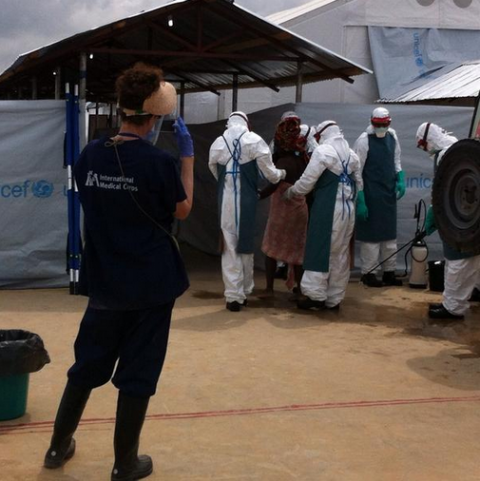
Above: Ramona Sunderwith watches the first patients arriving at the Lunsar Ebola Treatment Center in Sierra Leone on Monday, Dec. 1. Photo by Sam Ryder, via Twitter, and International Medical Corps.
Ramona Sunderwirth is an emergency pediatric physician who splits her time between New York City and a home in the Delaware County town of Bovina. She is spending her holiday season in Sierra Leone, the heart of the global Ebola virus epidemic. Part one of a series.
For Ramona Sunderwirth, Thanksgiving had to wait.
The Ebola treatment center in the town of Lunsar in Sierra Leone was supposed to open just before the holiday. But then the running water and electricity gave out.
"We don't have water," Sunderwirth said on Wednesday, Nov. 26. "We can't even put chlorine in water. All this is getting worked out, but it's just a big challenge."
The opening date got pushed back, and Sunderwirth spent Thanksgiving in a full-body suit (known as PPE, for personal protective equipment) inside sweltering 110-degree tents, drilling Sierra Leonean healthcare workers on infection prevention protocols.
Sunderwirth arrived in Sierra Leone in early November. Since Nov. 16, she's been in Lunsar, volunteering with the nonprofit medical aid group International Medical Corps, which is opening the first Ebola treatment center in the rural Port Loko District, two hours east of the capital city of Freetown. IMC is one of many entities building treatment centers in Sierra Leone (another is the British government) and being monitored by the World Health Organization.
On Monday, Dec. 1, thanks to the work of Sunderwirth and many others, the Lunsar Ebola treatment center began treating its first Ebola patients, according to an IMC spokesman.
It didn't happen a minute too soon. Sierra Leone is now the hottest zone of the Ebola epidemic. Between Nov. 5 and Nov. 26, 1,339 new cases were tracked in the country, compared to only a few hundred new cases each in neighboring Liberia and Guinea.
The virus has killed over 1,400 people in Sierra Leone, and yet only 40 percent of people who become infected there are isolated and hospitalized, according to Nov. 26 statistics from the World Health Organization.
Sierra Leone doesn't have enough treatment centers, hospitals and medical staff to keep up with the rising number of patients, according to the Wall Street Journal and the New York Times. The World Health Organization had hoped that the country would be treating 70 percent of its Ebola cases by Dec. 1, but the country fell far short of that goal on Dec. 1, treating just 40 percent of people with Ebola, according to Bloomberg News.
"It's really essential that we open this treatment center, because patients are being held in holding center isolation units, and a lot of them are dying there," Sunderwirth said. "The population has been really traumatized by the number of deaths, and a lot of patients are avoiding coming to the holding centers."

Above: Ramona Sunderwirth. Photo by International Medical Corps.
But even though the need to open the center was desperate, the need to protect and train local doctors and nurses in infection prevention was just as urgent.
"It's extremely challenging because we can't just open up; our staff has to be trained in how to protect themselves," Sunderwirth said. "The statistics show that the health care providers are at the highest risk of contracting Ebola. Everything has to be very carefully thought out and methodical. The care of the patients is very slow, because the staff has to be so careful about themselves."
Sunderwirth's job in Lunsar was to train the local Ebola healthcare workers to avoid getting infected. Her method was simple: drill, drill, drill. She led the doctors and nurses as they practiced protocols on volunteers, most of them Ebola survivors, pretending to be patients.
"They're in these big tents in 110-degree heat, with no air conditioning and no fans, in full PPE," Sunderwirth said. "We're only able to stay in for half an hour or 45 minutes maximum, and then we have to leave and go to a station where they're washed and sprayed by another team."

Above: Ramona Sunderwirth, right, in full PPE at the Ebola treatment center in Lunsar. Photo by Ramona Sunderwirth.
Every possible scenario was practiced. "We simulate all kinds of cases: a patient who dies, how patients have to be taken safety from the ambulance, agitated patients," Sunderwirth said. "We're setting up a system where women who have survived Ebola will come into Ebola units and take care of the babies whose parents have died."
Above Ramona Sunderwirth (middle top, with pink shirt) with fellow trainers and medical staff at a new Ebola treatment center in Lunsar, Sierra Leone. Photo by Ramona Sunderwirth.
Sunderwirth did eventually celebrate Thanksgiving--a day late, on Friday. There was no turkey, but there was chicken, stuffing, and even instant mashed potatoes; a nurse had thought to bring a box into Sierra Leone for the occasion.
There is much to be thankful for, Sunderwirth said.
"I'm thankful for being healthy, and for being able to help in this epidemic which is devastating this area," she said. "The people are so nice here, they're so friendly and so sweet, and so resilient. You see families with one survivor, and they smile and they come and help us train. They're a very generous people."
And in one respect, the holiday was just like it was at home:
"It isn't so unlike the Catskills," Sunderwirth said. "A town about an hour away has the only supermarket."
To support International Medical Corps' Ebola treatment centers, go to International Medical Corps' website at internationalmedicalcorps.org. Follow IMC on Twitter @IMC_Worldwide.














